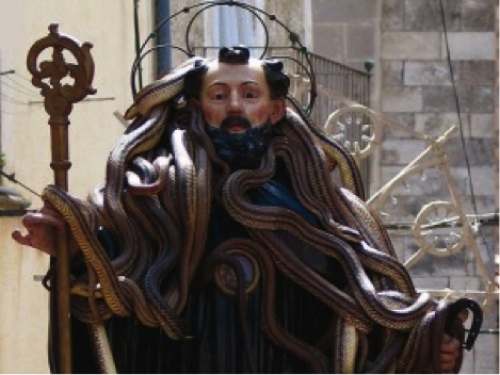During the summer months, Italy celebrates an eventful period which encompasses the traditions of a land that boasts ancient rituals, sometimes blending the sacred with the profane. A good example that has always caught my interest is the celebration of San Domenico Abate of Cocullo, a small town located in the province of L’Aquila, in the mountainous community of Peligna.
Every year, on the first Thursday of May, the residents of Cocullo gather together to celebrate the life of San Domenico Abate. Why is he so important for the town of Cocullo? The legend says healing capabilities from snake bites and reptiles, in general, could be attributed to this Saint. It is also known that Cocullo was the last military bastion belonging to the Holy Roman Empire before its fall and that its soldiers, called “Marsi,” worshipped Angitia, goddess of healing, by presenting snakes to her before going into battle to warrant her protection from snake bites.
Later on, with the onset of Christianity, this profane act was framed in a religious context by replacing the secular image of Goddess Angitia with the sacred image of San Domenico Abate, who originally was regarded as the healer of tooth pain. Nowadays, therefore, San Domenico Abate is regarded as protector - not just for toothaches, but also from reptile poison.
Each year, before the first Thursday in May, the serpari (people engaged in hunting snakes) go into the woods surrounding the small town of Cocullo and capture strictly non-poisonous snakes, which will be placed inside wooden boxes until the day of the procession. The day of the procession, following the celebration of a solemn Mass at 11 a.m., the snakes are first blessed and then donated by the serpari to the saint, whose statue will be completely covered with them near the neck and face. The people of Cocullo believe that depending on how the snakes and reptiles will intertwine and tangle, this can be a good omen for the town’s economy and prosperity.
Once the offering of snakes and reptiles to the Saint is over, the statue is paraded through the downtown streets of Cocullo, winged on either side by two women wearing the typical regional clothes and carrying (on their head) a basket containing five traditional sacred robes called ciambellati, in memory of a miracle attributed to San Domenico Abate. The ciambellati will then be offered at the end of the procession to the carrier of the statue of the saint. After the festivities, the serpari will transport and release the snakes back into the woods.
Back in the day, this ancient celebration was known only to the inhabitants of the village of Cocullo. Today, thanks to effective means of communication such as the internet, this celebration has become so popular that it is easy to meet numerous tourists flocking to the town of Cocullo on the first Thursday of May.
San Domenico Abate di Cocullo
Durante la stagione estiva, l'Italia vive un periodo ricco di eventi che racchiudono le tradizioni di una terra che vanta riti antichissimi.
Questi riti a volte contengono insieme la sacralità e la profanità. Un esempio tra questi, che ha sempre destato il mio interesse, è rappresentato dalla celebrazione di San Domenico Abate a Cocullo, un piccolo paesino che si trova nella provincia dell'Aquila ed è parte della comunità montana Peligna.
Ogni anno, il primo giovedì di maggio, gli abitanti del paese di Cocullo si stringono insieme per celebrare la figura di San Domenico Abate. Come mai San Domenico Abate è così importante per gli abitati di Cocullo?
Pare che a questo Santo siano attribuite le capacità di guarigione dai morsi di serpenti e di rettili in generale. Si narra che Cocullo era l'ultima forza militare appartenente al Sacro Romano Impero prima della sua decaduta ed i militari che si chiamavano i Marsi, come atto propiziatorio prima delle battaglie, offrivano alla Dea Angizia dei serpenti per avere una protezione da questi durante il combattimento.
In un secondo momento, con la giunta della cristianità, questo atto profano fu inserito nel contesto religioso tramite la sostituzione dell'immagine profana della Dea Angizia con l'immagine sacra di San Domenico Abate, al quale originariamente era attribuito il potere di guarire dal mal di denti. Oggi quindi, San Domenico Abate è protettore non solo per il mal di denti ma anche protettore dai morsi di serpenti e di rettili.
Ogni anno, prima del primo giovedì di maggio, i “serpari” (le persone addette alla cattura dei serpenti) si recano nei boschi circostanti il paese e catturano i serpenti, rigorosamente non velenosi, che saranno riposti dentro delle scatole di legno fino al giorno della processione.
Il giorno della processione, dopo la messa solenne delle 11:00 di mattina, questi serpenti vengono prima benedetti e poi donati dai “serpari” al Santo, il quale, sarà completamente ricoperto da rettili in prossimità del collo e della faccia. Gli abitanti di Cocullo credono al fatto che a seconda di come i serpenti e rettili si incrociano e si aggrovigliano, questo possa essere un segno di buon auspicio per il l’economia e la prosperità del paese.
Una volta finita l’offerta dei serpenti e rettili, la statua verrà trasportata per le strade della piccola cittadina di Cocullo passando nel centro storico, accompagnata al lato da due donne, le quali, indossano i vestiti tipici abruzzesi e trasportano in testa un cesto con all’interno cinque abiti sacri detti “ciambellati” , in ricordo ad un miracolo imputato a San Domenico Abate. Questi “ciambellati” saranno poi offerti alla fine della processione ai portatori della statua del Santo. Dopo la festa, i serpenti saranno riportati dai “serpari” nei boschi e liberati.
Un tempo questa antica celebrazione era nota solo agli abitanti del paese di Cocullo. Oggi, con i nuovi mezzi di comunicazione come internet, questa celebrazione è diventata più popolare quindi è facile incontrare molti turisti che affollano il paese di Cocullo il primo giovedì di maggio.



